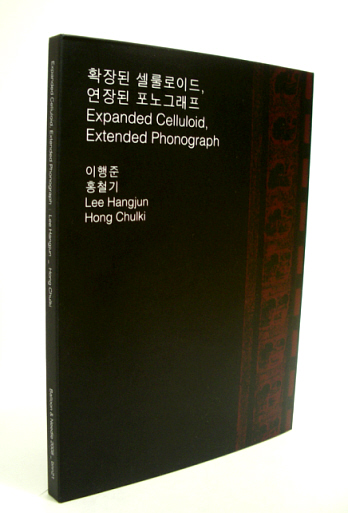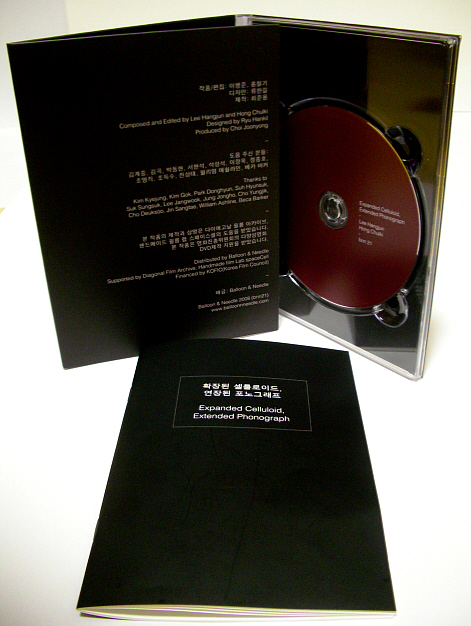
1. Cracked Share
2. Metaphysics of Sound
supplement. live performance at Kunst Doc
booklet included
running
time:69:20
bnn21
Lee Hangjun, Hong Chulki - Expanded Celluloid, Extended Phonograph
 |
1. Cracked Share booklet included
|
 |
|
released date |
format |
order |
price |
|
2008.6 |
DVD (NTSC 16:9 STEREO All REGIONS) |
20 USD |
Lee Hangjun: film
Hong Chulki: turntables
designed by Ryu Hankil
video samples
Cracked Share
Metaphysics of Sound
Lee Hangjun
He is an experimental film artist from Seoul, Korea. He collects film footage and does chemical work to oxidize emulsion on film surface. He also does contact printing work by copying film into blank film to make distorted images. His performance are shown by multiple projection with at least two analog projectors in various places such as galleries and theaters. His latest work
Hong Chulki
Since 1996, Hong Chulki from Seoul, Korea has been the founder and the member of the first Korean noise music group Astronoise (with Choi Joonyong). As a noise improviser, he has been playing mainly with feedback, amplifying the audio signal that passes through the audio devices, such as turntable, MD player, and laptop computer, and etc. In 2007, he has released two turntable (without records) solo discs, "5 Modules 2: Surface & Feedback" (Manual, Korea) and "Without Cartridge/With Cartridge" (Balloon and Needle, Korea) He has been active not only as an installation artist concentrated on vibration and feedback but also as an experimental film sound designer/music composer and theoretical worker of noise music and improvisation. (http://www.balloonnneedle.com/chulkien.html)
Quotes from the booklet
Seized in moments of visual detachment during periods of emotional contact, these images are oxidized residues of fixed light and chemical elements of transformed from living organisms.
- Carl E. Brown
I have been waiting for those who create music and visual just like them for more than 20 years.. They confront and challenge the problem at this departing point of audio and video.
- Otomo Yoshihide
Excerpt from "Shared Crack: How to Materialize the Visual-Aural Idea" by Kim Gok
Lee Hangjun, rather than capturing the actions of the object through the camera, has been working on chemical process, transforming film itself physically and chemically; Hong Chulki has been working on feedback playing or collaborative improvisation, without transmitter or receiver, using effect pedals or turntable. So to speak, the two artists have been exploring what the medium signifies, the potentiality of the medium itself distinguished from the representation or the power immanent in the medium. But we must not forget that their collaboration is worth more than just reflective research on the medium, the material itself. When Lee Hangjun was hammering the film strip to break silver grains inside it in "Cracked Share," and Hong Chulki was doubly mixing the sound footage of "Metaphysics of Sound," neither artist aimed to hear or see materials but instead the crack between them. They came close to finding not materials, but the relation between them, so to speak, the principle or power of the materials.
reviews
[review on Vital Weekly 641 by Frans de Waard]
Before I must have reported about the fact that cinema and art film are not my
cup of tea to review. Not because I don't like it, but because I don't know much
about it. I do watch films (see my review of 'Here's To Love' from a few weeks
back), and when it comes to experiments with media such as film I do very much
like Stan Brakhage's work. But its hard to place that in any sort of category or
write some intelligent words, offering insight. But since I like this one, I'll
give it a try. Hong Chulki we met before. This Korean musician plays with
feedback, turntables, laptop and minidisc. Here he works with film maker Lee
Hangjun, also from South-Korea. He treats his film with chemicals and always has
at least two screens to project on. Despite Chulki's laptop, this seems to me
foremost a work of analogue media. You can't sprinkle chemicals over windows
media player and see what the outcome is. But you can do over physical film. I
am not sure if Hangiun uses films he made himself, or that he is using old
film. The mixture of hectic noise based sounds, the feedback mixes with surface
of the record player (that most likely has no records spinning) along with the
rapid flickering of two images at the same time, create an almost hallucinating
affair. It's that Brakhage already made a film called 'Loud Visual Noise',
otherwise it would very appropriate to this. Noise as such is something which I
don't like very much at the moment, but when its presented like this, not noise
made visual, but a combination of noise as music, and noise as image, combined
together its something that I certainly am willing to see and hear, or hear and
see. (FdW)
[review by Brian Olewnick]
Both of Lee's videos use a similar format: twinned screens displaying generally
abstract imagery (though often infiltrated by footage from various sources)
based on film stock that appears to have been treated chemically including, one
guesses, by "natural" processes like heat, elemental exposure, maybe biological
growth) then reprocessed digitally. The film origin manifests in that upward
movement I've mentioned before, something I find a little distracting. The
images are usually formally related to each other, at least by a like corroded
quality, occasionally more directly via reflected, out-of-phase use of the same
image. The overall tone is in the brown/ocher range with flashes of other colors
and sometimes opposition of, say, bluish and flame orange aspects of otherwise
similar footage (very effective). There's an enormous sense of speed enhanced by
Hong's brutalist turntable, especially in the first piece, "The Cracked Share"
(think Yoshihide at his most violent); Hong's work is pretty great throughout.
The second piece, "Metaphysics of Sound", is somewhat more contemplative, the
imagery revolving around film sprocket holes, Hong using actual records as a
prime sound source (how old-fashioned! ;-)) and perhaps all the more effective
for pulling back a tad.
Do I like it? Well, yes but most often when I'mm
able to really immerse myself, something difficult to do via TV screen.
Imagining the works performed in a larger room, the images projected on walls
(perhaps being run in duplicate so one is surrounded), I think it would be quite
the experience. The supplemental track gives hints of just that and, again to
the extent you can place yourself in situ, it appears pretty fantastic.
[review on Paris Transatlantic by Dan Warburton]
Scratching the surface is what Lee Hangjun and Hong Chulki do very well, the
former playing with degraded, scuffed and generally fucked-up film stock (shades
of the Cellule d'Intervention Metamkine), the latter with his turntables.
Expanded Celluloid, Extended Phonograph features two half hour pieces, The
Cracked Share and Metaphysics of Sound, plus footage of a live performance in
February this year (well you don't actually see Hong Chulki manhandling his gear
but you get some idea of what the event might have looked like from the back of
the gallery), and comes with a beautifully produced 20-page booklet complete
with still photographs and stillborn (though well translated, it seems) text
courtesy filmmaker Kim Gok. Lee Hangjun's films split the screen into two,
drawing the eye inevitably to the vertical line that separates left and right,
as images scatter and splatter on either side. Most of them are abstract, rips,
gashes, holes, burns and all manner of corroded degradations flying past at high
speed, but from time to time recognisable images – cars, faces, clouds – appear.
Hong Chulki's ferocious turntablism, itself a corrosive mix of feedback squeals
and disturbing crunches and scratches (Otomo fans will love it) makes no attempt
to follow the film (how could it?), even when the images take an occasional
break – Metaphysics falls into distinct chapters – leaving more room for viewers
/ listeners to make the connections themselves. Which is as it should be.–DW